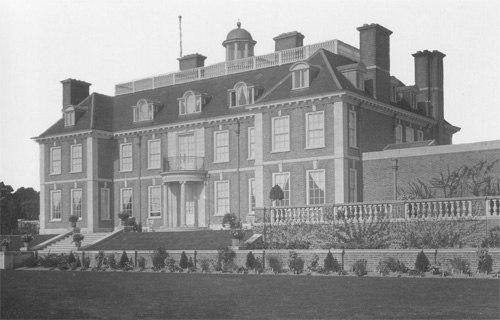Ardenrun Place
Surrey
| Location | Blindly Heath |
| Year demolished | 1933 |
| Reason | Fire |
| See all images: | Gallery |
| << Back to the main list |
Ardenrun Place was a short-lived yet architecturally notable English country house, constructed in 1909 for the banker Hans Henry Konig (1870–1949). Located near Lingfield in Surrey, it stood within an expansive 1,000-acre estate and was designed in the English Baroque style by the distinguished architect Ernest Newton (1856–1922), who later served as President of the Royal Institute of British Architects.
Origins and Architectural Design
 Hans Henry Konig, originally from New York, had strong ties to both Germany and the United States. Alongside his brother Frederick Adolphus Konig (1867–1940), he established the London-based banking firm Konig Brothers. Following the death of their father in Dresden in 1905, the brothers inherited considerable wealth. Frederick purchased Tyringham Hall in Buckinghamshire, while Hans elected to build anew in Surrey.
Hans Henry Konig, originally from New York, had strong ties to both Germany and the United States. Alongside his brother Frederick Adolphus Konig (1867–1940), he established the London-based banking firm Konig Brothers. Following the death of their father in Dresden in 1905, the brothers inherited considerable wealth. Frederick purchased Tyringham Hall in Buckinghamshire, while Hans elected to build anew in Surrey.
In 1906, Konig commissioned Ernest Newton to design Ardenrun Place. The house was constructed on elevated ground, a design decision not only practical for drainage and long-range views but also to establish prominence in the landscape. The Ardenrun estate, encompassing approximately 1,000 acres, was laid out as a complete working and leisure estate - a key characteristic of the Edwardian ideal of rural retreat combined with modern convenience. The estate also included a stable block and garages, designed by the architect John G. Gibb, M.S.A., who may have also been responsible for additional outbuildings including farm structures and an entrance lodge.
Internally, the house featured a mock-Tudor basement pub named the "Ardenrun Arms", a pseudo-historical interior which emulated the rustic charm of English inns, complete with heavy timbering, leaded glass, carved panelling, and pewter-topped bars. The grounds comprised not only a working farm but also a private golf course. Ardenrun Place received a 10-page spread in Country Life magazine in 1911, where it was described with restrained praise: "a pleasant specimen of a country house. It makes no pretence of being older than it is. It looks well already and, given proper upkeep, should look better as the years go on.".
Later Ownership and Decline
Hans Konig remained a bachelor. In 1921, citing health concerns, he sold Ardenrun and moved to Villa Maria Serena in Menton, on the French Riviera, a celebrated belle époque villa whose gardens are now open to the public.The next owner of Ardenrun was Captain Joel Woolf "Babe" Barnato (1895–1948), a millionaire racing driver and key figure among the so-called "Bentley Boys" - a group of wealthy sportsmen associated with Bentley Motors and Le Mans racing in the 1920s. Ardenrun gained notoriety during this period, as Barnato hosted his close friend Ettore Bugatti, who brought his eponymous racing cars to Surrey. The pair are reputed to have raced from the main house to Moat Farm and back along the half-mile drive.
Formal gardens likely surrounded the house, although detailed plans are lacking, but elements of them can be seen in Ordnance Survey maps with a fan-shaped spread of trees in front of the house, segmented by paths which provided views to the wider landscape.
Destruction and Legacy
On the night of 21 January 1933, a fire broke out on the upper landing near the nursery. Despite the efforts of the local fire brigade, the house was entirely gutted by the following morning. Ardenrun Place was never rebuilt. By the early 1970s, the once-celebrated gardens had become overgrown, and only one derelict wing of the house remained standing.Though its life was brief, Ardenrun Place stands as an interesting example of early 20th-century baroque revival architecture in the English country house tradition. Somewhere photos taken by the owners and many visitors must exist and could provide further insights into the interiors and the Gatsby-like lifestyle this house once enjoyed.